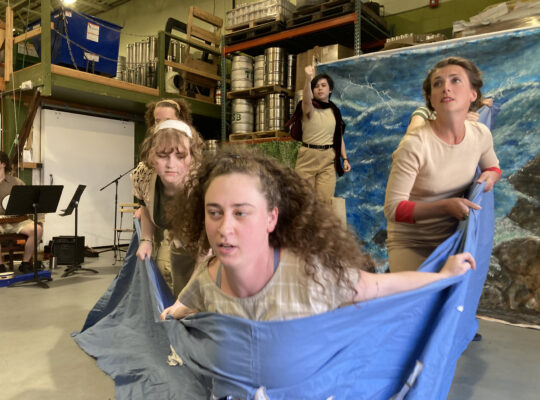[ad_1]
The centering process even inspired visual modifications to a deeply established performance venue. The interior design of the Guthrie Theater includes a series of glass-covered, backlit production photos illuminated from within the deep purple interior walls of the complex. When I visit, I routinely seek out an image from the 1988 production of Hamlet that changed my life, a young Julianne Moore as Ophelia staring back at me. But for For the People, a horizontal line of polymer panels conspicuously covered production photos that permanently line the outer wall of the McGuire Proscenium Stage. Each hand-painted square contained a single letter or numeral adorned by various Native-themed backgrounds. It took me a while to realize that the symbols running down the narrow lobby hallway combined to spell, “NEVER HOMELESS BEFORE 1492.” An inconspicuous museum label revealed that this artwork by Cortney Cochran (Anishinaabe) was originally installed on Franklin Avenue in 2018 beside one of Minnesota’s largest encampments of unhoused residents. Moved 1.3 miles from its original home to the Guthrie Theater on the bank of the Mississippi River (Ojibway for “great river), Cochran’s darkly comic art installation formed an environmental theatre threshold through which audience members must pass in order to enter the McGuire Proscenium Stage.
Once I was through the threshold, Tanya Orellana’s large and colorful scenic design immediately demanded attention. For The People takes place in a recently built community center on the aforementioned Franklin Avenue, a locus for the urban Native American community in Minneapolis. In addition to the now familiar axiom, “Never homeless before 1492,” the phrase “For the People” decorated the purple walls of the center, written in Dakota, Anishinaabe, and English. In her Instagram post, FastHorse revealed that “Orellana commissioned two local Native artists to adorn her set with murals.” The maximalist visuals of the entire design radiantly foreshadowed the well-meaning if overabundant enthusiasm of the play’s protagonist. Brightly-colored exercise balls, one even modified to look like a turtle, doubled as chairs for the community center visitors, hinting at the comedy to come.
While the multicolored murals added vibrancy and authenticity to mise-en-scène, other senses also received attention. Resident sound designer Victor Zupanc collaborated with Talon Bazille Ducheneaux (Cheyenne River Sioux, Lakota, Crow Creek Sioux Tribe, and Dakota) to score the auditory space with Indigenous-inspired music. Perhaps the most surprising (and amazing) design element appealed to olfactory sensations. Shortly before the lights dimmed, the unmistakable smell of burning sweet grass wafted through the audience. The Ojibway and other tribes often burn sweet grass to solicit positive energies at the start of important ceremonies. Whether we knew it or not, the large, mostly white audience participated in ritual designed to prepare us to enter into a state of transition or liminality.
In the tradition of magic realism present in Indigenous literature across the Western Hemisphere, the miraculous seeds grow overnight into an “extinct garden.” The past saves the present.
The Liminal Stage
Guided by Michael John Garcés’s skilled direction, the plot of For the People unfolded at a bouncy pace. The opening moments introduce April Dakota (Katie Anvil Rich, Cherokee and Chickasaw Descent), a young Native woman who grew up in Minneapolis, left for college and travel, but who has returned home to manage an American Indian Center on Franklin Avenue. Her wealthy father, Casino owner Robert Dakota (Kalani Queypo, Native Hawaiian and Blackfeet Descent) built the impressive facility for his daughter to run, but its final commission requires the approval of an eccentric, argumentative, and delightfully inefficient task force consisting of elders and community activists. April’s well-meaning if naïve attempts to gain the task force’s approval serve as the catalyst for the themes within the play.
In an interview in American Theatre, Defoe maintained that “working with the community in the Twin Cities has been a key part of the source material.” As expressed through passionate conversations and arguments, these community-derived themes include battles over identity (“Rez Indian” vs. “Urban Indian”), the definition of a “tribe,” the complicated question of how history is constructed and shared, and the overriding theme of gentrification (“Uptowning” vs “un-towning”). Not surprisingly, the script brims with local references. Examples include quips against the trendy Uptown neighborhood, a reference to Louis Erdrich’s Birchbark Bookstore located in the Uptown neighborhood, sweet corn pancakes at Maria’s Café on Franklin Avenue, and a brief reference to the now eleven-year-old artistic blunder by Walker Arts Center’s commissioning of Scaffold, a stunningly tone-deaf installation in which a white artist reconstructed the gallows used to hang thirty-eight Dakota men in 1862 in a community sculpture garden.
[ad_2]
Source link



 JEWISH DIGITAL TIMES
JEWISH DIGITAL TIMES








